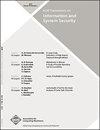Role Mining with Probabilistic Models
Q Engineering
ACM Transactions on Information and System Security
Pub Date : 2012-12-19
DOI:10.1145/2445566.2445567
引用次数: 44
Abstract
Role mining tackles the problem of finding a role-based access control (RBAC) configuration, given an access-control matrix assigning users to access permissions as input. Most role-mining approaches work by constructing a large set of candidate roles and use a greedy selection strategy to iteratively pick a small subset such that the differences between the resulting RBAC configuration and the access control matrix are minimized. In this article, we advocate an alternative approach that recasts role mining as an inference problem rather than a lossy compression problem. Instead of using combinatorial algorithms to minimize the number of roles needed to represent the access-control matrix, we derive probabilistic models to learn the RBAC configuration that most likely underlies the given matrix. Our models are generative in that they reflect the way that permissions are assigned to users in a given RBAC configuration. We additionally model how user-permission assignments that conflict with an RBAC configuration emerge and we investigate the influence of constraints on role hierarchies and on the number of assignments. In experiments with access-control matrices from real-world enterprises, we compare our proposed models with other role-mining methods. Our results show that our probabilistic models infer roles that generalize well to new system users for a wide variety of data, while other models’ generalization abilities depend on the dataset given.基于概率模型的角色挖掘
角色挖掘处理查找基于角色的访问控制(RBAC)配置的问题,给定一个为用户分配访问权限的访问控制矩阵作为输入。大多数角色挖掘方法的工作原理是构造一个大的候选角色集,并使用贪婪选择策略迭代地选择一个小子集,从而使最终的RBAC配置和访问控制矩阵之间的差异最小化。在本文中,我们提倡一种替代方法,将角色挖掘重新定义为推理问题,而不是有损压缩问题。我们不是使用组合算法来最小化表示访问控制矩阵所需的角色数量,而是推导概率模型来学习最有可能作为给定矩阵基础的RBAC配置。我们的模型是生成的,因为它们反映了在给定的RBAC配置中向用户分配权限的方式。此外,我们还对与RBAC配置冲突的用户权限分配如何出现进行了建模,并研究了约束对角色层次结构和分配数量的影响。在真实企业访问控制矩阵的实验中,我们将我们提出的模型与其他角色挖掘方法进行了比较。我们的研究结果表明,我们的概率模型推断出的角色可以很好地泛化到各种各样的新系统用户,而其他模型的泛化能力取决于给定的数据集。
本文章由计算机程序翻译,如有差异,请以英文原文为准。
求助全文
约1分钟内获得全文
求助全文
来源期刊

ACM Transactions on Information and System Security
工程技术-计算机:信息系统
CiteScore
4.50
自引率
0.00%
发文量
0
审稿时长
3.3 months
期刊介绍:
ISSEC is a scholarly, scientific journal that publishes original research papers in all areas of information and system security, including technologies, systems, applications, and policies.
 求助内容:
求助内容: 应助结果提醒方式:
应助结果提醒方式:


